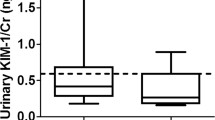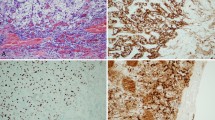Abstract
Background
Kidney injury molecule-1 (KIM-1) is a sensitive biomarker for proximal tubular injury. Recently, a few studies have shown that urinary KIM-1 has clinical implications in IgA nephropathy (IgAN). We performed this study to determine whether tissue KIM-1 has clinical implications for predicting long-term outcome and whether urinary KIM-1 is correlated with tissue KIM-1 and kidney injury in IgAN patients.
Methods
We assessed the prognostic prediction capability of tissue KIM-1 expression in 69 adult patients with IgAN retrospectively. Renal biopsies from all patients were scored by a pathologist who was blinded to the clinical data for the pathologic variables. The primary outcome was the composite of a 50 % reduction in eGFR or end-stage renal disease. Tissue KIM-1 expression was assessed semiquantitatively by counting the stained tubules per 100× power field; 0 tubule indicates grade 0; 1–5 tubules, grade 1; 6–10 tubules, grade 2; and more than 10 tubules, grade 3. Comparing urinary KIM-1 and tissue KIM-1 expression, 50 consecutive IgAN patients were prospectively enrolled to measure urinary KIM-1 levels and examine their biopsy specimens by KIM-1 immunohistochemistry.
Results
Univariate analysis showed that tissue KIM-1 expression was associated with the renal outcome in IgAN. Multivariate regression analysis, as the relationship of tissue KIM-1 with prognosis, was consistent. Proteinuria at biopsy and tissue KIM-1 grade 3 were shown to have a prognostic value. The concentration of urinary KIM-1/Cr in patients with IgAN was significantly higher than that in the normal controls.
Conclusion
Tissue KIM-1 expression is an independent predictor of adverse renal outcomes in IgA nephropathy patients.



Similar content being viewed by others
References
Alamartine E, Sabatier JC, Guerin C, Berliet JM, Berthoux F. Prognostic factors in mesangial IgA glomerulonephritis: an extensive study with univariate and multivariate analyses. Am J Kidney Dis. 1991;18:12–9.
D’Amico G. Influence of clinical and histological features on actuarial renal survival in adult patients with idiopathic IgA nephropathy, membranous nephropathy, and membranoproliferative glomerulonephritis: survey of the recent literature. Am J Kidney Dis. 1992;20:315–23.
Haas M. Histologic subclassification of IgA nephropathy: a clinicopathologic study of 244 cases. Am J Kidney Dis. 1997;29:829–42.
Johnston PA, Brown JS, Braumholtz DA, Davison AM. Clinico-pathological correlations and long-term follow-up of 253 United Kingdom patients with IgA nephropathy. A report from the MRC Glomerulonephritis Registry. Q J Med. 1992;84:619–27.
Bohle A, Mackensen-Haen S, von Gise H, Grund KE, Wehrmann M, Batz C, et al. The consequences of tubulo-interstitial changes for renal function in glomerulopathies. A morphometric and cytological analysis. Pathol Res Pract. 1990;186:135–44.
Roberts IS, Cook HT, Troyanov S, Alpers CE, Amore A, Barratt J, et al. The Oxford classification of IgA nephropathy: pathology definitions, correlations, and reproducibility. Kidney Int. 2009;76:546–56.
Cattran DC, Coppo R, Cook HT, Feehally J, Roberts IS, Troyanov S, et al. The Oxford classification of IgA nephropathy: rationale, clinicopathological correlations, and classification. Kidney Int. 2009;76:534–45.
Coppo R, Troyanov S, Camilla R, Hogg RJ, Cattran DC, Cook HT, et al. The Oxford IgA nephropathy clinicopathological classification is valid for children as well as adults. Kidney Int. 2010;77:921–7.
Peters HP, Waanders F, Meijer E, van den Brand J, Steenbergen EJ, van Goor H, et al. High urinary excretion of kidney injury molecule-1 is an independent predictor of end-stage renal disease in patients with IgA nephropathy. Nephrol Dial Transpl. 2011;26:3581–8.
Xu PC, Zhang JJ, Chen M, Lv JC, Liu G, Zou WZ, et al. Urinary kidney injury molecule-1 in patients with IgA nephropathy is closely associated with disease severity. Nephrol Dial Transpl. 2011;26:3229–36.
de Borst MH, van Timmeren MM, Vaidya VS, de Boer RA, van Dalen MB, Kramer AB, et al. Induction of kidney injury molecule-1 in homozygous Ren2 rats is attenuated by blockade of the renin–angiotensin system or p38 MAP kinase. Am J Physiol Renal Physiol. 2007;292:F313–20.
Ichimura T, Hung CC, Yang SA, Stevens JL, Bonventre JV. Kidney injury molecule-1: a tissue and urinary biomarker for nephrotoxicant-induced renal injury. Am J Physiol Renal Physiol. 2004;286:F552–63.
Ichimura T, Bonventre JV, Bailly V, Wei H, Hession CA, Cate RL, et al. Kidney injury molecule-1 (KIM-1), a putative epithelial cell adhesion molecule containing a novel immunoglobulin domain, is up-regulated in renal cells after injury. J Biol Chem. 1998;273:4135–42.
Katafuchi R, Kiyoshi Y, Oh Y, Uesugi N, Ikeda K, Yanase T, et al. Glomerular score as a prognosticator in IgA nephropathy: its usefulness and limitation. Clin Nephrol. 1998;49:1–8.
Risdon RA, Sloper JC, De Wardener HE. Relationship between renal function and histological changes found in renal-biopsy specimens from patients with persistent glomerular nephritis. Lancet. 1968;2:363–6.
Bartosik LP, Lajoie G, Sugar L, Cattran DC. Predicting progression in IgA nephropathy. Am J Kidney Dis. 2001;38:728–35.
Donadio JV, Bergstralh EJ, Grande JP, Rademcher DM. Proteinuria patterns and their association with subsequent end-stage renal disease in IgA nephropathy. Nephrol Dial Transpl. 2002;17:1197–203.
Zhang Z, Humphreys BD, Bonventre JV. Shedding of the urinary biomarker kidney injury molecule-1 (KIM-1) is regulated by MAP kinases and juxtamembrane region. J Am Soc Nephrol. 2007;18:2704–14.
Catania JM, Chen G, Parrish AR. Role of matrix metalloproteinases in renal pathophysiologies. Am J Physiol Renal Physiol. 2007;292:F905–11.
Conflict of interest
The authors have no competing interests.
Author information
Authors and Affiliations
Corresponding author
About this article
Cite this article
Kwon, S.H., Park, M.Y., Jeon, J.S. et al. KIM-1 expression predicts renal outcomes in IgA nephropathy. Clin Exp Nephrol 17, 359–364 (2013). https://doi.org/10.1007/s10157-012-0707-2
Received:
Accepted:
Published:
Issue Date:
DOI: https://doi.org/10.1007/s10157-012-0707-2




